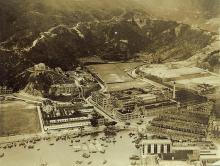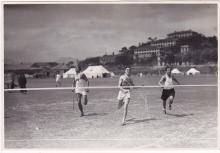Hong Kong Electric Company's staff quarters, Causeway Hill [c.1926-c.1964]
Primary tabs
Update 29 Mar 2018: These have been identified as staff quarters for Hong Kong Electric - see Ashley's comment below.
The location of the marker is approximate, but photos appear to show the three buildings on the slope above the Shing Kwong Church.
I think they could be connected with the Belilios Reformatory that was nearby, possibly as accommodation or classrooms, but I'm not sure yet.
In pre-war photos they each have a pitched, tiled roof. Post-war photos show buildings with a flat roof, but otherwise they look very similar. I guess they were damaged during the war years, then renovated with flat concrete roofs after the war.
Can you tell us more about them? Please leave a comment below.





Comments
These three buildings had
These three buildings had always puzzled me. They look like institutional buildings rather than private properties, and, like many of us, I assumed they were part of the Belilios Reformatory or related facilities for juveniles. Then, I stumbled upon a street index calling the place "Causeway Hill" (I.L. 2462) and a breakthrough was made! An article in 1926 talking about HK Electric Co building thirteen houses at Causeway Hill and confirmatory evidence in 1927 (as well as other years') Jurors List were found!
http://sunzi.lib.hku.hk/hkgro/view/s1927/2350.pdf
An entry read "Arnold, Morris Hadrian - Electrical Engr., HK. Electric Co., Ld - Causeway Hill Quarters No. 1a"
They were quarters for technical staff of HK. Electric Company!
Buildings identified
Thanks Ashley, it's good to have that mystery solved. Now we know what to look for, I found another mention on the front page of The China Mail, 1931-11-02:
A series of thefts from the Hong Kong Electric Company’s quarters at Causeway Hill during the past few months had its sequel this morning when Tsui Chung-po, (15), employed as house coolie, was charged before Mr. Schofield on two counts: [...]
Also, searches for the current building on this site, Fontana Gardens, show several cases where its address is given as "Causeway Hill": https://www.google.com.hk/search?ei=5su8Wq_XLJCQvQS6lJbYBg&q=fontana+gar...
I am delighted too to have
I am delighted too to have solved the mystery. The project (building quarters at Causeway Hill) was also mentioned in the book "A Mountain of Light: the Story of the Hong Kong Electric Company" by Austin Coates.
As for the end-date, I would go for 1964. The lot was sold by HK Electric Co. in late 1963 and the early phase of Fontana Gardens was completed in 1965. The buldings must have been demolished by 1964 and probably not earlier than late 1963.
Hong Kong Electric Staff Quarters on Causeway Hill
Hello Ashley,
Many thanks for your excellent effort in identifying not only the purpose of those three structures but also more importantly reviving the name Causeway Hill which most present local residents do not know. As a student of the Eastern Hospital Road Government Primary School ( now Sir Ho Tung Secondary School ) I witnessed the blasting works that preceeded the construction of the first phase of the Fortana Garden. I left this school in 1963 and promoted to a secondary school in the same area.
With regards,
Tai Hang Wong
HKEC Staff quarters Causeway Bay Hill
The Sloan Family lived there at No 4 and No 5 From about 1946/7 till about 1955 I think. Several other families like the Gregory's, the Bonch's the Connery's and the Gibson lived there about this time. Real Colonial life style house with servants quaters and gardens with veg patches also. I will try to add some photos of this location.
Flat Roof of the three HK Electric Quarters
The 1946-47 So Kon Po picture by Hedda Morrison may prove the flat roofs of the three buildings were constructed during the post war restoration work.
Reference to Causeway Hill Quarters
1925 Hong Kong Electric Co. Annual Report - HK Telegraph 12 March 1926 refers
Good progress was made with the scheme for housing the Company's technical staff and at the end of year (1925), the thirteen houses at Causeway Hill were nearing completion.